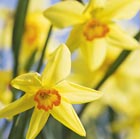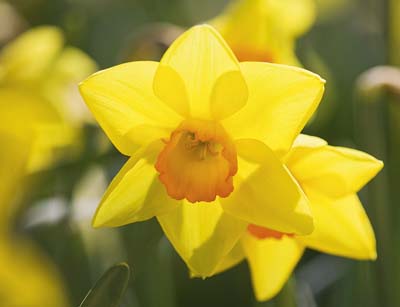A remarkable daffodil collection
View an inspiring collection of daffodils in south Cornwall


Ahuddle of wintry, windbreak trees stands fast on the ridge of the hill. On the seaward side, waves crash onto the Cornish coastline; landward, a gently sloping hillside lies smothered in ribbon-like golden rows of dancing daffodils. A fifth of the world's narcissi bulbs and a wealth of cut flowers are produced in Britain's warm and westerly tip, as they have been for more than 150 years.
Daffodils are commonplace in Cornwall and, from Christmas through to Easter, its patched fields of yellows and whites flutter with cheerful blooms. But this is no ordinary field; it belongs to Ron Scamp, winner of countless prestigious awards, including 23 RHS Gold Medals, and is the home of his comprehensive and internationally renowned collection.
More than 2,500 named varieties are grown here on the edge of Falmouth, some 300 of which are of Mr Scamp's own breeding. (An adjoining ‘nursery' field holds 500 as yet unnamed seedlings, some of them likely to be the favoured daffodils of tomorrow, presently on trial, awaiting judgement.)
As a small boy, Mr Scamp spent much time with his uncles, Peter and Dan du Plessis, narcissi growers in the Tamar valley.Dan also had a fine reputation for daffodil breeding, introducing the admired new double daffodils of his day, Gay Kybo and Tamar Fire.
He taught young Ron all he knew and the pair travelled across the country to exhibit prize blooms at horticultural shows, seek out new and old daffodil varieties and generally mix with the like-minded. It was a way of life for Ron, who picked Bath's Flame daffodils for Dan 60 years ago. ‘As a 10 year old, working Uncle Dan's farm, it was my favourite because it was a "quick picker" and I was keen to get my job done and shoot off to go fishing.'
A passion for daffodils flourished through his formative years and, after pursuing a more mainstream career in retail management (but always with plenty of daffodils in tow), Mr Scamp returned to settle in Cornwall, where he nurtured a burgeoning collection, selling initially a small amount of bulbs and a handful of cut flowers. The first mail-order catalogue followed in 1991, but, today, the family business, run with his son, Adrian, represents all 13 daffodil divisions, growing on 14 acres of loamy Cornish ground.
New varieties to offer customers are the lifeblood of many a nursery and, for Scamps, 2013 saw nine introductions, including locally named Plymouth Hoe, a bold yellow-and-orange trumpet daffodil, plus gleaming white Lincolnshire Lady and Centenary Gold. When the latter was ‘just a number', it was named the 2012 Cornwall Garden Society Nurseryman's Best Plant and was christened, post-award, to commemorate the society's 100th anniversary.
Exquisite houses, the beauty of Nature, and how to get the most from your life, straight to your inbox.

These debutantes join other homegrown beauties such as the delightful Creed, a N. cyclamineus hybrid with white, reflexed petals and a yellow trumpet; yellow-petalled and orange-cupped Katherine Jenkins; yellow-and-orange-cupped Cape Cornwall; pink-cupped and white-petalled cyclamineus Kathy's Clown; and the robust yellow-and-orange double-flowered Madam Speaker.
Amid all the novelties, Mr Scamp retains a passion for heritage varieties and has found many pre-Second World War varieties, creating a living museum of daffodils. ‘Many perished, having been grubbed up during the war in the Dig for Victory effort,' he explains. He has tracked down many a forgotten daffodil and ‘repopulated' it.
He fondly grows row upon row of the aforementioned Bath's Flame (pre 1913), a small-cupped daffodil in brilliant yellow and orange. Ron recommends this, as well as many other historical varieties, as being garden or show-bench worthy. Another good choice is White Lady (his favourite), which has beautiful white-and-yellow, lightly perfumed flowers. Mrs R. O. Backhouse (1921) is famously the first ‘pink' daffodil and Lucifer (1890) has a small, yellow trumpet and fluttery white petals.
Mr Scamp's reverence and respect for those who fight for our country is witnessed by the modern varieties he names on their behalf: Welsh Warrior (2011) is a superb, bright, all-yellow trumpet type, named for the 200th British soldier to fall in Afghanistan, and golden Gallipoli Dawn, just released, commemorates those who fought in the Dardanelles Campaign in preparation for its centenary in April 2015.
R. A. Scamp, 14, Roscarrack Close, Falmouth, Cornwall TR11 4PJ (01326 317959). Dates for the 2014 charity Walk and Talk visits subject to weather-will be posted on the R. A. Scamp website at www.qualitydaffodils.com, on which you can also order bulbs
Ron Scamp's ‘best of the best'
Historical
Bath's Flame, White Lady, Irene Copeland and Sulphur Phoenix-‘it outgrows many modern varieties despite its 200-year-old pedigree'
Modern
Rapture-‘beautiful, with reflexed petals' Rosemoor Gold-‘a wonderfully scented, bold, jonquilla type' Tête-à-Tête-‘grow and leave in the ground forever' Rijnveld's Early Sensation-‘you'll sometimes get flowers before Christmas'
Species
Narcissus poeticus var. recurvus, the old pheasant eye-‘absolutely the last to flower; it has a delicious scent and likes quite a damp situation'
* Subscribe to Country Life and save
* Follow Country Life on Twitter
Country Life is unlike any other magazine: the only glossy weekly on the newsstand and the only magazine that has been guest-edited by His Majesty The King not once, but twice. It is a celebration of modern rural life and all its diverse joys and pleasures — that was first published in Queen Victoria's Diamond Jubilee year. Our eclectic mixture of witty and informative content — from the most up-to-date property news and commentary and a coveted glimpse inside some of the UK's best houses and gardens, to gardening, the arts and interior design, written by experts in their field — still cannot be found in print or online, anywhere else.
